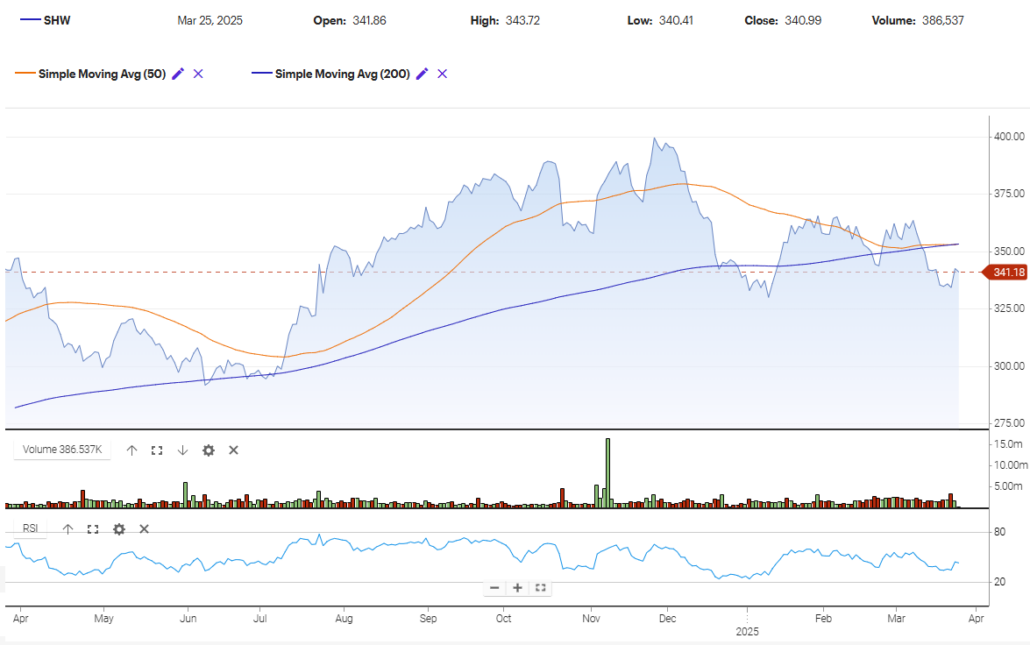Updated 3/26
Sherwin-Williams isn’t just another industrial company—it’s a brand that’s been part of American homes and businesses since the 1800s. Known for its wide range of paints and coatings, it has become the dominant player in its space, not just in the U.S. but globally. From residential touch-ups to commercial construction projects, SHW products are nearly everywhere. For income-focused investors, this company brings a rare mix of staying power and shareholder-friendly policies, especially when it comes to dividends.
Let’s explore what makes Sherwin-Williams tick from a dividend investor’s lens.
Key Dividend Metrics
💵 Forward Dividend Yield: 0.92%
📈 5-Year Average Yield: 0.84%
📅 Dividend Growth Streak: Over 45 years
📊 Payout Ratio: 27.11%
🛡️ Dividend Safety: High
🚀 5-Year Dividend CAGR: Around 16%
📆 Last Dividend Paid: March 14, 2025
📉 Trailing Dividend: $2.86
🔮 Forward Dividend: $3.16
Recent Events
Sherwin-Williams wrapped up 2024 with solid momentum. Earnings per share came in strong at $10.54, up significantly from the prior year, thanks to improving margins even as overall revenue growth remained modest. At $23.1 billion in revenue, the top line was flat, but what stood out was how efficiently the business converted that into bottom-line results.
That efficiency translated into yet another dividend hike. The new annual payout of $3.16 keeps the company’s impressive growth streak alive, a move that further cements its position as a shareholder-friendly name. Even with economic uncertainty and a higher-rate environment, Sherwin-Williams generated over $3 billion in operating cash flow and almost $2 billion in free cash flow—more than enough to cover its dividend and then some.
Dividend Overview
Sherwin-Williams isn’t the place you go for a sky-high dividend yield. Sitting just under 1%, it won’t turn heads based on income alone. But that’s not the point here. The story is all about consistency and growth. A payout ratio of only 27% tells us there’s plenty of room to keep raising that dividend without putting pressure on the balance sheet.
What really gives this stock its appeal is how long it’s been growing its dividend. Over four decades without a skip is a powerful signal. Even if the checks aren’t massive, they’re steady—and they’ve been rising at a healthy clip.
Dividend Growth and Safety
Here’s where things get interesting. Sherwin-Williams has been raising its dividend at a much faster rate than the typical blue-chip name. Around 16% per year over the last five years—now that’s impressive.
The company’s return on equity sits around 69%, which is off the charts. That kind of performance doesn’t happen by accident. It’s a clear reflection of a company that knows how to squeeze results out of its capital.
Yes, there’s a good chunk of debt on the books, but management has proven it can handle it. The consistent free cash flow and low payout ratio give Sherwin-Williams a wide margin for safety. Unless something dramatically shifts in its business model, the dividend looks secure for the long haul.
Chart Analysis

Current Market Phase
Looking at the chart for Sherwin-Williams, it appears the stock is transitioning out of a distribution phase and may be entering early markdown. After peaking in late 2024, SHW experienced a noticeable decline that broke below the 50-day moving average and, more recently, slipped under the 200-day moving average—typically a red flag for sustained weakness. The price now hovers around $341, slightly beneath the 200-day average, which is beginning to flatten. The 50-day moving average has turned lower and is trending below the 200-day, which forms a classic death cross pattern—generally not a bullish sign.
This shift suggests the euphoric markup period is behind us. The steady rise through mid-2024 with rising price highs and a supportive 50-day average fits well within the markup characteristics. But that structure began deteriorating late in the year. Distribution likely occurred during the choppy, sideways action from November to January, with the stock forming a series of lower highs and losing momentum. Volume spikes during this period reinforce that smart money was likely selling into strength.
Volume Behavior
Volume has remained relatively average throughout the recent slide, with a few spikes that suggest forced selling or institutional exits—most notably the big green bar in November, which didn’t lead to a sustained move higher afterward. That pattern often marks a buying climax or early distribution when large trades push the price up briefly before fizzling. Since then, volume has not shown strong accumulation, and there’s been no meaningful follow-through from buyers.
Relative Strength Index (RSI)
The RSI has trended below the midpoint for most of 2025, confirming the bearish shift in momentum. The most recent RSI reading is moving off oversold levels but remains below 50, which typically suggests the downtrend is still intact. There hasn’t been a clear divergence yet to hint at a reversal.
Recent Candle Activity
Looking at the most recent five candles:
- The last two sessions show narrow bodies and long lower wicks—suggesting some buying pressure at the lows but no commitment from bulls.
- One of the candles posted a small real body near the bottom of its range, which tends to reflect indecision rather than strength.
- No high-volume bullish engulfing or reversal candle has formed to mark a real shift in sentiment.
- The candles remain below both major moving averages, which reinforces the lack of a bullish bias.
- Wick-to-body ratios are hinting at some intraday volatility, but not the kind of aggressive buying that typically confirms a floor is in.
From a Wyckoff lens, this positioning suggests early markdown is now underway after a completed distribution range. Sellers are gradually taking control, and support appears to be weakening. The market is not yet showing signs of accumulation.
Analyst Ratings
📉 On March 10, 2025, Jefferies shifted its stance on Sherwin-Williams, moving the rating from a strong buy to a hold. Along with the downgrade came a reduced price target, trimmed from $423 to $380. This more cautious tone likely stems from concerns about slowing momentum in key end markets and the broader uncertainty around construction and housing-related demand.
🟢 Back on February 26, 2025, Citigroup initiated coverage on SHW with a strong buy rating and placed a price target of $423. Their positive view was rooted in Sherwin-Williams’ consistent margin improvement and robust free cash flow, which continue to support long-term growth and capital returns. They also noted the company’s pricing power as a strength in navigating raw material cost fluctuations.
📈 On February 3, 2025, JP Morgan reiterated its buy rating while nudging the price target higher, from $370 to $390. Their revised estimate factored in better-than-expected operating leverage and a favorable mix shift that’s helped drive earnings resilience even in a choppy demand environment.
📊 As of the most recent analyst consensus, Sherwin-Williams holds a “Moderate Buy” rating across 18 analysts. The average price target sits at $401.13, with estimates spanning from a low of $370 to a high of $425. That midpoint suggests roughly 17% upside from the current share price around $344.
These recent updates reflect a blend of cautious optimism and recognition of Sherwin-Williams’ fundamental strengths—namely its steady cash generation, margin discipline, and long-standing position in a mature, defensible industry.
Earning Report Summary
Sherwin-Williams wrapped up 2024 on a solid note, showing it can still deliver stable growth even when things aren’t exactly smooth across the board. The company’s latest earnings report gave investors a mix of optimism and realism—there’s strength in key areas, but also some headwinds to keep an eye on.
Fourth Quarter Highlights
In the final stretch of the year, Sherwin-Williams pulled in $5.3 billion in net sales. That’s up slightly from the same quarter the year before. Most of that lift came from its Paint Stores Group, which continues to be the company’s workhorse. Sales in that segment rose just over 3%, thanks to steady demand in residential repaint projects and decent performance in new residential construction. On the flip side, sales dipped a bit in the Consumer Brands and Performance Coatings groups, but not enough to drag down the overall numbers.
Earnings for the quarter came in strong. Net income hit $480 million, translating to $1.90 per diluted share—well above the $1.39 reported a year ago. Adjusted earnings, which smooth out one-time items, reached $2.09. That’s a healthy bump and speaks to how well Sherwin-Williams is managing its operations.
Full-Year Snapshot
For the full year, Sherwin-Williams posted record sales of $23.1 billion. It wasn’t explosive growth, but it was enough to push earnings upward. Full-year earnings per share landed at $10.55, up over 14% from the year prior. Adjusted EPS was even stronger at $11.33, marking almost 10% growth.
One of the more encouraging notes from the year was cash flow. Sherwin-Williams generated $3.15 billion in operating cash, which gave it plenty of breathing room to return capital to shareholders. In total, the company gave back $2.46 billion through dividends and share buybacks.
A Look at the Business
Management pointed out that demand was uneven across different markets. Residential repainting stood out with strong growth, while industrial sales got a boost from packaging and coil coatings. Gross margins also improved, rising to 48.5% for the year—another sign the company is keeping costs in check and maintaining pricing power.
What’s Ahead
Looking into early 2025, Sherwin-Williams expects more of the same: some pockets of strength, but overall demand could stay soft. First quarter sales are expected to come in around flat to slightly up, while full-year guidance points to low single-digit growth. The company’s adjusted earnings forecast for 2025 is in the range of $11.65 to $12.05 per share.
It’s not overly flashy, but it’s steady. And for long-term investors, especially those watching cash flow and dividend strength, that kind of reliability still matters.
Financial Health and Stability
The balance sheet isn’t squeaky clean. Debt stands at $12.1 billion, and cash is under a quarter of a billion. With a current ratio of 0.79, short-term liabilities outweigh liquid assets, which might look like a red flag on the surface.
But here’s the thing—Sherwin-Williams has the kind of business that throws off reliable cash. Operating cash flow of $3.15 billion gives it breathing room. This is a company that doesn’t need a fortress-like balance sheet because it has dependable revenue and the kind of pricing power that helps it stay resilient.
Margins back this up. Profit margins north of 11% and operating margins above 12% are solid numbers for a company in the materials sector. That level of profitability gives Sherwin-Williams the cushion it needs to navigate interest rate shifts or raw material price bumps.
Valuation and Stock Performance
There’s no getting around it—Sherwin-Williams isn’t cheap. With a forward P/E nearing 29 and a price-to-book ratio well above 20, investors are clearly willing to pay a premium. The PEG ratio is sitting close to 3.9, suggesting that even factoring in expected growth, you’re still paying a full price.
The stock has pulled back from its high of $400 to around $344, trailing the broader market over the past year. But that kind of underperformance isn’t unusual for a stock that had been riding high for so long.
For long-term investors, this isn’t a momentum play—it’s about trusting that the business, and its dividends, will keep growing steadily over time.
Risks and Considerations
No investment comes without risk, and Sherwin-Williams is no exception. The debt levels are high, and in a world where interest rates aren’t going back to zero anytime soon, that can add strain.
There’s also exposure to the housing market to consider. If new builds slow or renovation activity dips, demand could soften. We’ve already seen revenue flatten out, and that could continue if macro conditions turn.
And then there’s the valuation. When you buy at a high multiple, there’s less room for error. If earnings disappoint, the stock could get hit harder than something already trading at a discount.
Final Thoughts
Sherwin-Williams is the kind of stock that rewards investors who appreciate patience. The dividend won’t make anyone rich overnight, but the consistency, growth, and financial discipline make it a standout in the income space.
It’s a name that’s weathered countless business cycles, raised its dividend like clockwork, and found ways to grow in both strong and weak economies. For investors focused on dependable dividends and solid long-term execution, Sherwin-Williams still deserves a close look.

